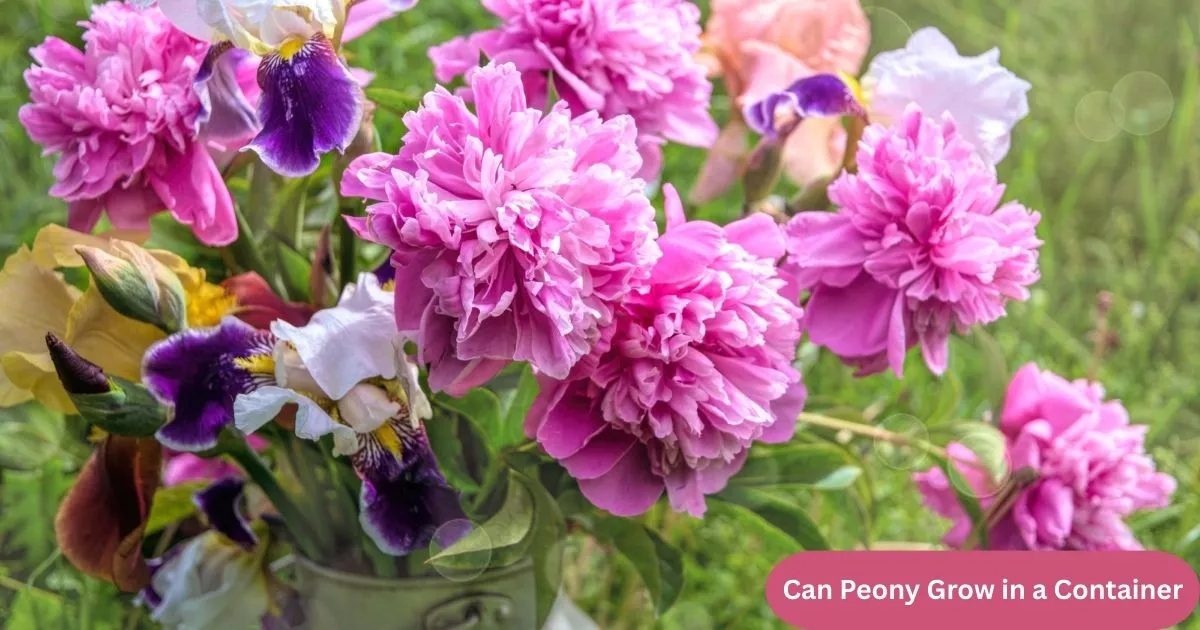Peonies are beloved for their stunning blooms and delightful fragrance, making them a popular choice in gardens. While they’re traditionally grown in garden beds, you may be wondering if it’s possible to grow peonies in containers. The good news is that peonies can thrive in pots, provided they receive proper care and attention.
Growing peonies in containers allows you to enjoy their beauty in smaller spaces like patios, balconies, or even porches. With the right container, the right variety, and a little extra care, container-grown peonies can bloom beautifully year after year. In this article, we’ll explore how to grow peonies successfully in containers and ensure they thrive.
Choosing the Right Container
The first step in growing peonies in containers is choosing the right pot. The container must be large enough to accommodate the peony’s root system. A pot with a diameter of at least 18 to 24 inches is recommended. Make sure the container has drainage holes to prevent waterlogging, which can harm the plant.
When selecting a container, consider the material. Plastic pots are lightweight and retain moisture, but clay or ceramic pots can add a decorative touch to your garden or patio. Whichever material you choose, ensure the container is sturdy enough to support the peony’s growth, especially when it reaches its full size.
Choosing the Right Peony Varieties
Not all peonies are suitable for container growth. Herbaceous peonies, which die back to the ground in winter, are the most common type for containers. These varieties have smaller root systems compared to tree peonies, making them easier to grow in pots.
Some good herbaceous peony varieties for containers include ‘Sarah Bernhardt’ and ‘Festiva Maxima.’ These varieties are known for their fragrant, large blooms and manageable growth. Tree peonies can also be grown in containers, but they require larger pots and extra care due to their woody stems.
Planting Peonies in Containers
Planting peonies in containers is similar to planting them in the ground. Start by filling the bottom of the container with a layer of gravel or broken pottery to help with drainage. Then, add a well-draining potting mix, making sure it’s rich in organic matter.
When planting the peony, ensure the root eyes are positioned just below the soil surface. The root eyes, small buds on the roots, are crucial for the plant’s growth and should not be buried too deep. Plant the peony at the same depth as it was in its nursery pot, and cover it with soil.
Providing the Right Growing Conditions
Peonies need plenty of sunlight to thrive, so place your container in a spot that gets at least six hours of direct sunlight a day. Full sun is essential for healthy peony plants and vibrant blooms.
Additionally, peonies prefer cooler temperatures and may struggle in extremely hot climates. If you live in a hot area, try to position the container where it will be shaded during the hottest part of the day. This will help protect the plant from excessive heat while ensuring it receives adequate sunlight.
Watering Peonies in Containers
Watering peonies in containers requires some attention. These plants like consistent moisture, but they do not tolerate soggy soil. It’s essential to water the peony thoroughly, but allow the soil to dry out slightly between waterings. Overwatering can lead to root rot, so it’s important to strike the right balance.
Make sure the container has good drainage to allow excess water to escape. If your container is in a location with heavy rain, you may need to move it to a more sheltered spot to prevent water from accumulating in the pot. A good rule of thumb is to water when the top inch of soil feels dry to the touch.
Fertilizing Peonies in Containers
Peonies in containers may need extra feeding compared to those planted in the ground. These plants benefit from a slow-release fertilizer that will provide nutrients throughout the growing season. Apply the fertilizer in early spring when new growth begins, and again after the first flush of blooms fades.
Avoid over-fertilizing peonies, as this can lead to excessive foliage growth at the expense of flowers. Use a balanced fertilizer with equal amounts of nitrogen, phosphorus, and potassium. Organic options, such as compost or bone meal, can also be beneficial for container-grown peonies.
Pruning and Deadheading Peonies
Pruning is an important part of container care for peonies. After the flowers fade, it’s a good idea to deadhead the spent blooms to encourage more flowers and keep the plant looking tidy. Simply snip off the old flower heads with clean, sharp scissors.
In the fall, when the peony’s leaves begin to yellow and die back, cut the plant back to about 2 to 4 inches above the soil level. This will help prepare the peony for winter dormancy. Be sure to clean up any fallen leaves to prevent fungal diseases from taking hold.
Winter Care for Container-Grown Peonies
Peonies grown in containers are more vulnerable to cold temperatures than those in the ground. To protect your peony during the winter, move the container to a sheltered spot, such as a garage or a porch. Alternatively, you can insulate the pot by wrapping it with burlap or placing it in a larger container filled with mulch.
If you live in a very cold climate, you may need to bring the container indoors during the harshest winter months. Just be sure to provide enough light, as peonies need some sunlight even in winter. If moving the container inside isn’t possible, bury the pot in the ground to protect the roots from freezing.
Common Issues with Growing Peonies in Containers
While growing peonies in containers can be rewarding, there are a few common issues to watch out for. One problem is root rot, which occurs when the soil is too wet. Ensure your container has proper drainage and avoid overwatering to prevent this.
Peonies can also suffer from pests, such as aphids or ants, that may attack the blooms or leaves. Regularly inspect your plant for signs of insects and take action as needed. You can treat aphids with insecticidal soap or by using natural predators like ladybugs.
Conclusion
In conclusion, growing peonies in containers is a great option for those with limited space or who want to add beauty to patios, balconies, or small gardens. With the right container, proper care, and attention to watering, sunlight, and fertilization, peonies can thrive in pots just as well as in the ground.
While they require some extra maintenance, such as protection from extreme temperatures in winter, container-grown peonies can reward you with stunning blooms year after year. With careful planning, these lovely flowers can become a cherished part of your container garden.
Read More: Can Peony Grow in a Container
FAQ’s
Can peonies be grown in small containers?
No, peonies need large containers with at least 18-24 inches in diameter.
Do peonies require full sun?
Yes, peonies need at least six hours of direct sunlight each day.
How often should I water peonies in containers?
Water peonies when the top inch of soil feels dry to the touch.
Can peonies survive winter in containers?
Yes, but you may need to move them to a sheltered spot or insulate the pot.
Do I need to prune peonies in containers?
Yes, deadhead spent flowers and cut back the plant in fall to prepare for winter.









